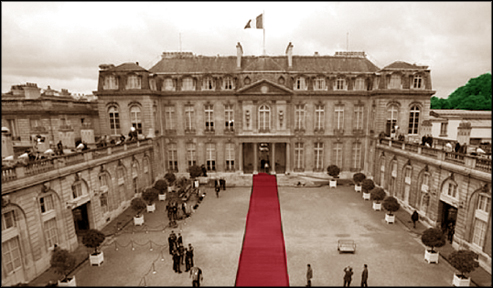 Parisian Presidential Palace
by Nilma Dole
Taking a walk on the Champs
Elysees, one can’t help but divert from the hustle and bustle of the
cosmopolitan organized chaos to the private corner where the Elysees
Palace is located. Thinking if President Nicolas Sarkozy and his lovely
wife Carla Bruni Sarkozy might be romancing in this magnificent palace
where they got married, the Elysees Palace is a treat for tourists now
that the French couple have hit world headlines.
 The official residence of the President of the French Republic,
containing his office, the Elysees Palace is also where the Council of
Ministers meet. Important foreign visitors are hosted at the nearby
Hotel de Marigny, a palatial residence. The Gardens of elysees is the
popular location where the president hosts a party in the afternoon of
Bastille Day. The official residence of the President of the French Republic,
containing his office, the Elysees Palace is also where the Council of
Ministers meet. Important foreign visitors are hosted at the nearby
Hotel de Marigny, a palatial residence. The Gardens of elysees is the
popular location where the president hosts a party in the afternoon of
Bastille Day.
The elysee Palace came into existence when architect Armand-Claude
Mollet who owned some property facing the road front of the Roule
village (west of Paris now the Rue du Faubourg Saint-Honore) falling
into the royal property, the Grand Course sold it in 1718 to Henri Louis
de La Tour d’Auvergne, comte d’vreux with the understanding that Mollet
would construct an hotel particular for the count.
The Hotel d’vreux was finished and decorated by 1722, having had many
modifications, it remains a fine example of the French classical style.
At the time of his death in 1753, vreux was the owner of one of the most
widely admired houses in Paris, and it was bought by King Louis XV as a
residence for the Marquise de Pompadour, his mistress.Opponents showed
their distaste for the regime by hanging signs on the gates that read:
“Home of the King’s whore”. After her death, it reverted to the crown.
In modern French history after various ownership changes and after
the Russians camped there, though it was first officially used by the
government of Napoleon Bonaparte, the Hotel d’vreux was formally
purchased for Louis XVIII in 1816. Under the provisional government of
the Second Republic, it took the name of the Elysees National and was
designated the official residence of the President of the Republic. The
President also has the use of several other official residences,
including the Chteau de Rambouillet, forty five kilometres southwest of
Paris, and the Fort de Bregançon near Marseille.
In 1853, following his coup d’etat that ended the Second Republic,
Napoleon III charged the architect Joseph-Eugne Lacroix with
renovations; meanwhile he moved to the nearby Tuileries Palace, but kept
the elysee as a discreet place to meet his mistresses, moving between
the two palaces through a secret underground passage that has since been
demolished.Since Lacroix completed his work in 1867, the essential look
of the Palais de l’elysee has remained the same.
Today, the Elysees Palace is a beautiful sight to see how French
architecture and much of its historical value is still intact because
the French surrendered easily. They are blessed with a historical city
with hardly any changes because it wasn’t bombed or destroyed. Likewise,
the Elysees Palace is a fitting example of how you can have the
old-world charm shine radiantly in this modern era of design and
construction. |

